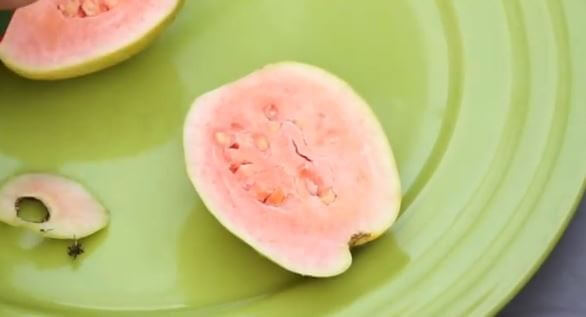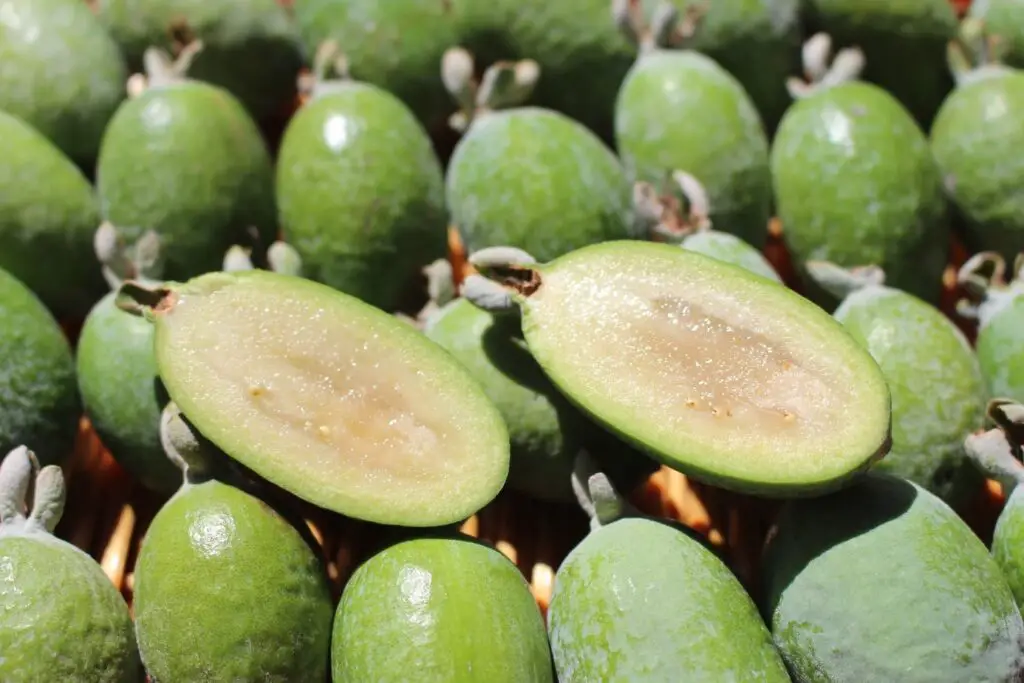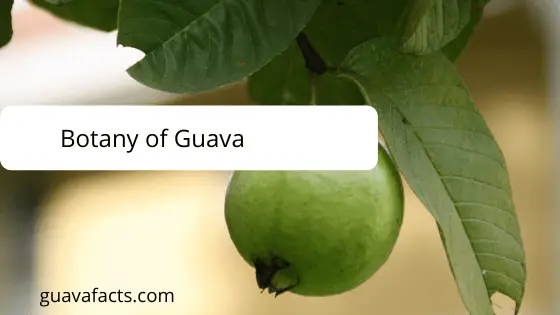In this guide, you are going to learn the botany of guava plant, distribution, propagation, types, benefits, and side effects of the guava plants.
Let’s get started.
Overview
Botanically, guava is scientifically known as Psidium guajava and it is native to tropical Americal Americas. Guava is a shrub typically of not more than 5-10m but can sometimes reach a height of 15m. The trunk is covered with greyish-brown bark that is smoothed and flaky. The leaves are simple and oppositely arranged with the entire leaf margin. The flowers have 4 petals and 4 sepals with numerous stamens. Fruits are round with light green to the yellow outer skin and juicy pulp that is perforated with many with seeds.
Taxonomic Classification
Guava plants can be classified taxonomically into division, class, order, family, and genus.
Botanical Classification Of Guava
Kingdom Plantae
Subkingdom Tracheobionta
Superdivision Spermatophyta
Division Magnoliophyta
Class Magnoliopsida
Subclass Rosidae
Order Myrtales
Family Myrtaceae
Genus Psidium L
Tracheobionta
Tracheobionta are a group of plants commonly known as vascular plants.
They have both vascular bundles of xylem and phloem. This shows that plants under tracheobionta transport food and water through a network of advanced and well developed connective tissues.
Guava also belongs to this phyla, however, unlike lower plants such as Bryophyta and Pteridophyta, the vascular tissues of guava are well developed.
Spermatophyta
This is a subdivision of plants that bear seeds or produce seeds through the exchange of eggs and sperm between male and female plants.
Guava reproduces through fertilization or spermatogenesis to produce seeds, and this makes guava falls to the phylum Spermatophyta.
Magnoliophyta
Magnoliophyta are a group of plants popularly known as flowering plants.
They are named as flowering plants because they produce flowers and endosperm within the seeds.
Flowering plants (Magnoliophyta) are well adopted and diverse group of land plants because they can be found even at harsh and extreme weather conditions on land and water.
Guavas fall under this division because they produce flowers, endosperms, and fruits that contain the seeds.
Learn more about magnoliophyta
Magnoliopsida
This is a class of angiosperms or flowering plants that produce seeds with two embryonic leaves.
Guava also produces an embryo with two cotyledons or leaves.
Rosidae
This is a subclass of plants with over 50000 species, mainly recognized or characterize with features such as pinnately compound leaves.
Common members of the subclass Rosidae are maples, roses, grapes, and guava.
Myrtales
This is an order of plants typically compost dicotyledonous flowering woody plants with flaky bark.
The leaves of plants in this order are opposite and have a characteristic of narrow basal petals.
Myrtaceae
Myrtaceae is a family of woody shrubs and trees. The plants within this family posses aromatic leaves that have oils glands.
The flowers produce by Myrtaceae are normally white, pink, red, purple, and yellow. The petals and sepals are usually 5 with abundant stamens.
Psidium L.
Psidium is a genus that guava which guava belongs to. The genus was first brought to the scientific world by Linnaeus in 1753. Most of the species in this genus are edible fruits, and this makes the genus economically important and widely cultivated.
Species
The common tropical guava species name is called guajava. There are other species that share the same genus with the tropical guava.
If you need an in-depth guide on the species of guava, read our guide to wild and cultivated species of guava here
Below are some few examples:
1. Genus: Psidium
Species: amplexicaul Pers
Common name: mountain guava
2. Genus: Psidium
Species: calyptranthoides Alain
Common name: luquillo mountain guava
3. Genus: Psidium
Species: guineense Sw
Common name: guinea guava
Learn more about classification of guava plant here
Types
There are commonly three types of guava with different forms and varieties. However, the types of guavas we mentioned below are not the only types of guavas that are commonly cultivated. Learn more about the types of guava plants and fruits here.
The few types we want to discuss here are:
- Tropical guava
- Pineapple guava
- Strawberry guava
In terms of forms and color, there are two main types of guava.
These are:
- Pink- and Red-fleshed guava
- White- and Yellow-fleshed guava
Pink- and Red-fleshed guava Type

- Produce berry fruits
- They produce aromatic fruits
- The fruits produced are very sweet
- They are also known as desert guava
Common varieties
- Homestead guava (Psidium guajava ‘Homestead’, growing in USDA Zones 9a to 11)
- Honk Kong Pink (Psidium guajava ‘Ong Kong Pink’, USDA Zones 9b to 11)
- Red Indian (Psidium guajava ‘Red Indian’, USDA Zones 9b to
White- and Yellow-fleshed guava

- Produce fruits with little to no aroma
- The flesh of the fruits can be creamy white to yellow, and the outer skin normally becomes green when mature
Common Varieties
- Mexican cream (Psidium guajava ‘Mexican Cream’, USDA Zones 9b to 11)
- White Indian (Psidium guajava ‘White Indian’ USDA Zones 9b to 11)
As stated earlier, there are three main types of guava. The tropical guava is common form of guava which is scientifically known as Psidium guajava.
Learn more about guava varieties.
The other two relatives share any resemblance with the tropical guava.
These are:
- Strawberry guava
- Pineapple guava
The strawberry guava produce fragrant and spicy fruits which look like the tropical guava. In size, the fruits are normally 1-11/2 inches in diameter. The fruits also have wrinkled red skin and creamy white flesh.
On the other hand, the pineapple guava also posses fragrant fruits similar to the tropical guava, however, even when they are ripen, the skin that covers the fruits of pineapple guava is rough and dark green.
Unlike, the tropical guava, pineapple guava can suitably grow up to 10-15 feet in height with an equal spread.
-

strawberry guava -

pineapple guava
Characteristics of guava
Psidium guajava which is known as tropical guava is common that possesses most of the characteristics of other guavas. Thus, the following features are for Psidium guajava and other guavas.
- Evergreen
- Shrubby or small tree
- The origin of guava is unknown, however, it was found to be native to some parts of tropical America
- Guava produce flowers
- Posses edible fruit
- Posses slender trunk, which is sometimes with smooth green or red-brown bark
- Possess oval or elliptical leaves
- The upper surface of the leaves is smooth, while the lower surface is hairy
- The flowers are solitary and white
- The fruit of guava is oval and green to yellow in color
- The inner part of the guava the fruit is fleshy which can be white yellow, pink, and red in color with numerous yellowish seeds
- Guava may live up to 40 years
- Guava can grow up to 10m (33ft) in height
Reproduction
In normal physiological conditions, Psidium guajava can reproduce at any time of the year. It produces viable pollen that can last for more than 42 hours. On the other hand, the stigmas are ready to accept the pollen for up to two days.
The primary pollinating insects are bees. This is because the flowers produced by guava are sweet and have a pleasant aroma.
However, sometimes guava can reproduce by self-pollination. Guava shows a characteristic of a hermaphrodite system. It produces numerous seeds that are taken by birds and mammals.
The seeds of guava were found to retain their normal viability for an estimated time of one year at an average temperature of 8C and low humidity.
Seed Dispersal
Guava species reproduce usually by seeds, however, guava can also be propagated by suckers and stumps.
The common method of seed dispersal is by animals such as man, fruit-eating birds, and bats. The seeds can also be dispersed by wind and water.
How to Propagate Guava from Cuttings
Growing your own personal garden is quite simple and you do not need to break your bank account to do that. One of such simplest fruits for gardening is guava.
The common tropical guava and its relatives are ones of the few simple shrubby trees that produce fruits after two to three years of germination.
Method
To propagate guava by cuttings, just cut 4-6 inch (10-15cm) sucker or any pliable stumps. The cuttings should be pliable and free from breaking when bent.
Strip the leaves of the suckers and suck the bottom of the cuttings in the rooting hormone for about one hour.
Then, plant the cuttings in a moist nylon or potting mix that is filled with hummus, 50% normal soil and 50% cocopit.
If are you using nylon mix, cover the medium with another transparent nylon bag. You should ensure that there is not any space that air can get access to the inside of the nylon mix.
But, if you are using a potting mix, cover the potting medium with a clear plastic wrap.
In order to prevent the plastic wrap from touching the leaves of the cuttings, use 4 bamboo sticks (source) to hold the plastic wrap above the leaves.
Place your propagating medium under the sun where the temperature is constantly between the range of 75 to 85F (24-29C) 24 hours round.
Take note of any growth changes after 14 to 25 days of planting. At this time, the cuttings have started rooting. Then, remove the plastic wrap during this time, and water slowly to keep the propagating medium slightly moist.
Transplant the rooted cuttings into a big container in a warm room. Then, replant the plant when it is mature enough to survive on its own.
Learn more on how to grow guava plant from cuttings here
Habitat of a guava tree
As described by the Agroforestry Centers in 2002 (source), the original habitat of guava is savannah or shrub ecotones or frequently disturbed land.
However, several studies have shown that the origin of guava is not clear. The exotic range of guava tree is tropical forests, however, it was found to invade pasture and grassland, and riparian habitats.
Guava can grow in both dry and humid climatic conditions at an altitude of 1500-2200m. it requires a mean temperature of 20-30C for optimal growth. The annual rainfall requirement is between 1000-2000m.
if you want to know more about the habitat of a guava tree, read our guide on the habitat of guava plant here.
Economic Importance
Guava and its relatives are very diverse with numerous ecological and economic importance.
Below we discuss the benefits and side effects of guava:
Health Benefits
Guava contains numerous energy and bodybuilding phytochemicals, which they work perfectly in the body to improve healthy living.
Below are some of the common uses and health benefits of guava:
- Guava helps boost the immune system of the body
- Guava might help reduce glucose level in the body
- It aids in easing menstrual cramps
- Guava is rich in fiber and water, which aids in digestion
- It is used in treating cancer
- It might help lower cholesterol level in the body
- It is used in the treatment of various skin ailments
Learn more about guava health benefits here.
Side Effects
- Guava leaves extract is found to cause nausea and vomiting in some people
- The extract of guava leaves might also result in skin allergy and irritation to some people when applied on the skin
- Guava leaf extract might worsen eczema
- Guava is not recommended prior to surgery
Frequently asked Questions
What is the botanical name of guava?
Guava’s scientific name and family are Psidium guajava and Myrtaceae.
The botanical name of guava may sometimes differ because the guava plant has many varieties and species. However, the most common encounter guava botanical name is Psidium guajava then followed by the variety name.
What is the family of guava?
Guava plant belongs to the family Myrtale or Myrtaceae.
What characteristics are common to guava?
Guava is a small shrub of not more than 15-20m in height. The branches are sparsely arranged with evergreen leaves that are aromatic and oppositely arranged. The leaf margin is entire. The length of the leaves is usually 4-8cm. Leaves have prominent veins on the underside that look like ribs. The flowers usually group from1 to 3 with many stamens that are arranged on a width disk. The fruits are round to oval.
Are guava worms harmful?
The common worm of guava that is mostly found is Argyresthia eugenietha. And this worm is considered safe. However, it is always good to remove all worms before you eat guava.
Is Guava A Flowering Plant?
Guava is a flowering plant. and the flowers produced are usually white and about 2.5cm.
Which Guava Is Best?
The best-known guava varieties are Mexican white and white Arabian guavas. However, this can differ from one individual to another.
Conclusion
In this guide, we have discussed the classification of guava where we looked at the different taxonomic classification of guava starting from the kingdom, division, class, order, family, genus, and the different species under the genus.
We went ahead to look at the different types of guavas and varieties. We also discussed the reproduction, seed dispersal, propagation by cuttings, and the economic importance of guava.
References
“Australian National Botanic Gardens” retrieved from here
“Aberystwyth university. Magnoliphyta” retrieved from here
Cronk QCB, Fuller JL, 1995. Plant invaders: the threat to natural ecosystems. London, UK: Chapman & Hall
“Guava (Psidium guajava)” retrieved from here on 12/05/2020
“PLANT VILLAGE” diseases, pests, propagation, characteristics
“USDA Natural RESOURCES CONSERVATION SERVICES” retrieved from here
Wikipedia contributors. (2020, April 12). Rosidae. In Wikipedia, The Free Encyclopedia. Retrieved 20:17, May 6, 2020, from
Wikipedia contributors. (2019, March 24). Psidium. In Wikipedia, The Free Encyclopedia. Retrieved 09:57, May 7, 2020, from here
“Species and types” retrieved from here



